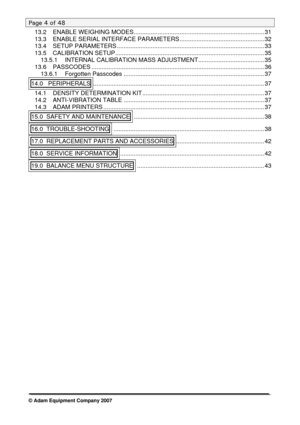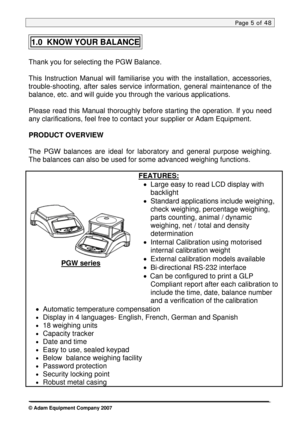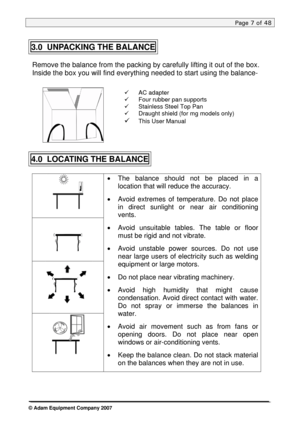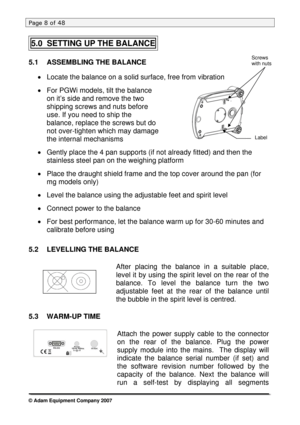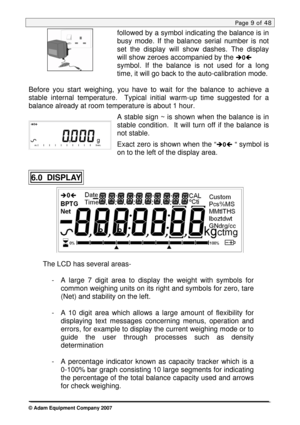Adam Equipment PGW Precision Balances PGWuserrevE4 User Manual
Here you can view all the pages of manual Adam Equipment PGW Precision Balances PGWuserrevE4 User Manual. The Adam Equipment manuals for Balance are available online for free. You can easily download all the documents as PDF.
Page 1
Adam Equipment PGW SERIES (P.N. 8080, Revision E4, September 2007) Software rev.: 2.43 & above © Adam Equipment Company 2007
Page 3
Page 3 of 48 TABLE OF CONTENTS 1.0 KNOW YOUR BALANCE........................................................................\ ..................5 2.0 SPECIFICATIONS........................................................................\ .............................6 3.0 UNPACKING THE BALANCE........................................................................\ ............7 4.0 LOCATING THE BALANCE........................................................................\...
Page 4
Page 4 of 48 13.2 ENABLE WEIGHING MODES........................................................................\ .....31 13.3 ENABLE SERIAL INTERFACE PARAMETERS..................................................32 13.4 SETUP PARAMETERS........................................................................\ ...............33 13.5 CALIBRATION SETUP........................................................................\ ................35 13.5.1 INTERNAL CALIBRATION MASS...
Page 5
Page 5 of 48 1.0 KNOW YOUR BALANCE Thank you for selecting the PGW Balance. This Instruction Manual will familiarise you with the installation, accessories, trouble-shooting, after sales service information, general maintenance of the balance, etc. and will guide you through the various applications. Please read this Manual thoroughly before starting the operation. If you need any clarifications, feel free to contact your supplier or Adam Equipment. PRODUCT OVERVIEW The PGW balances...
Page 6
Page 6 of 48 2.0 SPECIFICATIONS Model* PGW 153e PGW 253e PGW 453e PGW 753e PGW 1502e PGW 2502e PGW 3502e PGW 4502e Maximum capacity 150g 250g 450g 750g 1500g 2500g 3500g 4500g Readability 0.001g 0.01g Tare range Full Repeatability (S.D.) 0.001g 0.01g Linearity (±) 0.002g 0.02g Units of measure grams, milligrams (for 0.001g units only), kilograms, carats, pennyweights, grains, troy ounce, ounces, pounds, drams, taels (Hong Kong, Taiwan and Singapore), mommes, tolas,...
Page 7
Page 7 of 48 3.0 UNPACKING THE BALANCE Remove the balance from the packing by carefully lifting it out of the box. Inside the box you will find everything needed to start using the balance- 9 AC adapter 9 Four rubber pan supports 9 Stainless Steel Top Pan 9 Draught shield (for mg models only) 9 This User Manual 4.0 LOCATING THE BALANCE • The balance should not be placed in a location that will reduce the accuracy. • Avoid extremes of temperature. Do...
Page 8
Page 8 of 48 5.0 SETTING UP THE BALANCE Screws with nuts5.1 ASSEMBLING THE BALANCE • Locate the balance on a solid surface, free from vibration • For PGWi models, tilt the balance on it’s side and remove the two shipping screws and nuts before use. If you need to ship the balance, replace the screws but do not over-tighten which may damage the internal mechanisms • Gently place the 4 pan supports (if not already fitted) and then the stainless steel pan on the weighing platform...
Page 9
Page 9 of 48 followed by a symbol indicating the balance is in busy mode. If the balance serial number is not set the display will show dashes. The display will show zeroes accompanied by the Î0Í symbol. If the balance is not used for a long time, it will go back to the auto-calibration mode. Before you start weighing, you have to wait for the balance to achieve a stable internal temperature. Typical initial warm-up time suggested for a balance already at room temperature is about 1 hour....
Page 10
Page 10 of 48 SYMBOLS AND TEXT The LCD has unique symbols to indicate the following: Î0Í Zero Busy Stable A bar graph with set point markers g, mg, kg, ct, dwt, GN, ozt, oz, lb, dr, tl H, tl T, tl S, MM, T, ti, N, Custom, g/cc, Pcs, %, M, and S Symbols shown for the units INDICATORS “CAL” When calibration is occurring or about to occur “ºC” When a temperature is shown or a temperature driven calibration is to occur “ti” For a time driven calibration “Net” When a...



